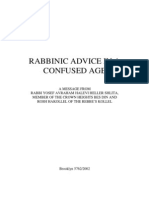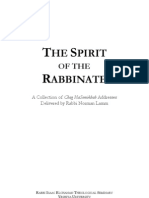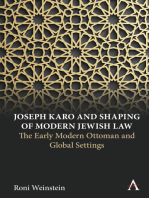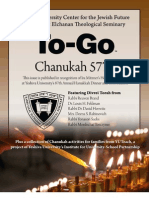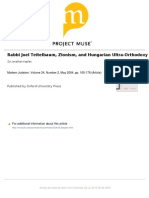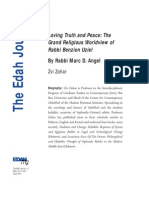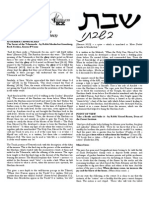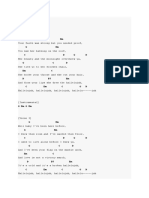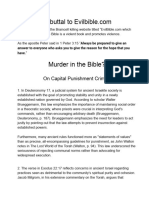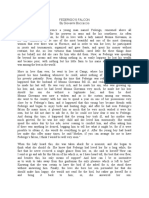Terumah 5775
Terumah 5775
Uploaded by
mizrachicanadaCopyright:
Available Formats
Terumah 5775
Terumah 5775
Uploaded by
mizrachicanadaOriginal Description:
Copyright
Available Formats
Share this document
Did you find this document useful?
Is this content inappropriate?
Copyright:
Available Formats
Terumah 5775
Terumah 5775
Uploaded by
mizrachicanadaCopyright:
Available Formats
Shabbat-B'Shabbato Parshat Teruma
2 Adar 5775 (21 February 2015)
AS SHABBAT APPROACHES
Transparency - by Rabbi Oury Cherki, Machon Meir,
Rabbi of Beit Yehuda Congregation, Jerusalem
Even though building a House for G-d is a Torah mitzva (Rambam,
Hilchot Beit Habechirah) and the Torah will never change (Rambam,
Thirteen Principles), there are some differences about the way the
Temple was built at different times, in accordance with the words of
G-d as handed down by the prophets.
Therefore, the plan of the Tabernacle in the desert was not the same
as that in Shilo, and they were not the same as the designs of the First
and Second Temples, or the Third Temple of the future which
appears in the prophecy of Yechezkel. The reason for this is that the
Temple is a reflection of the heavenly world in our world, "like the
image that you were shown on the mountain" [Shemot 25:40]
something akin to the ideal world of Plato. The spiritual world
changes form to correspond to changing times, and therefore the
appearance of the Temple on the earth changes too.
One of the details that is different between the Tabernacle as
described in the Torah portion of Teruma and the Temple of Shlomo
as described in the Haftarah of Teruma is that in the Tabernacle there
are no windows, while the Temple built by King Shlomo does have
some. Thus, the Divine inspiration in the desert was meant for
Yisrael exclusively, without any contact with the other nations of the
world, because at that point Yisrael was just coming into existence
and had the experience of an intimate wedding ceremony with the
Creator "The love of our betrothal, when you followed Me into the
desert." [Yirmiyahu 2:2]. When Shlomo arrived, the time had come
for the active universal influence of Bnei Yisrael, when the entire
world came to hear the wisdom of Shlomo. This was therefore the
proper time to make windows in the Temple, indicating a point of
contact between Yisrael and the other nations.
The passage describes "transparent blocked windows" [Melachim I
6:4]. Targum Yonatan writes that the windows were "open on the
inside and blocked on the outside." This is an indication the holy was
able to absorb from the profane that is, the Jews absorbed from the
non-Jews. This is also what Rav Kook implies in Orot Hatechiyah
(Chapter 15). However, see the RADAK: "The sages felt that the
opposite was true: the windows were open to the outside and blocked
on the inside. This is to say that the people of Yisrael had no need for
the light of the world." According to this, the windows indicated that
holiness was sent out from the holy site to the outside, without being
influenced by the outside (this corresponds to the earlier commentary
of Rav Kook, Ein Ayah Bikurim 27).
We can say that there is no dispute in principle between the two
approaches. Rather, the first one describes the actual situation. The
nation of Yisrael is not afraid of external influences when the
Shechina has appeared within it. The second commentary describes
the essential difference between Yisrael and the other nations,
something which grants Yisrael a feeling of security.
The Metzudot explains that the windows were made of glass, at one
and the same time both transparent and blocked. This commentary
seems to combine the two above approaches described above.
However, in order to combine the external and internal influences it
is necessary to create new technology, such as glass, which is invented
at a later stage, as part of the world's development.
Rabbi Cherki is the head of Brit Olam Noahide World Center,
Jerusalem
POINT OF VIEW
What are they Doing to Abba Kahaneman in
Ponevezh? - by Rabbi Yisrael Rozen, Dean of the
Zomet Institute
There are three crowns: The crown of royalty is the Table, about
which it is written that it has a golden crown around it. The crown of
the priesthood is the Altar, about which it is written that it has a
golden crown around it. And the crown of Torah is the Ark, about
which it is written, a golden crown... Why is it not common for the
children of Torah scholars to be scholars too? ... It is so that people
will not say that Torah is their inheritance." [Nedarim 81a].
An Evil Spirit in the Sanctuary
There is an evil spirit blowing on the hill of the Yeshiva of
Ponevezh in Bnei Berak, the model for all the "Lita'i Yeshivot."
This yeshiva has become a brand name in the "world of the Torah,"
and it has received much praise as a result of its many graduates who
hold prominent positions in the realms of the rabbinate, as judges in
the religious court, education, and various Chareidi activities. The
"Lita'i"-analytical method of study has become the main technique in
the "world of the yeshivot," and it also serves as a model in Chassidic
and Sephardi yeshivot. It is also the most prominent technique in the
analytical study of Talmud in the many types of Zionist yeshivot. In
the "competition" among the most prominent Lita'i and Jerusalem
yeshivot, Mir and Chevron, the press has given Ponevezh a title of
nobility: "Oxford of the Yeshivot."
The crown, the glory, and the fame are all reserved in this yeshiva for
the merits of its founder, the illustrious Rabbi Yosef Shlomo
Kahaneman, who fled alone from the Holocaust (only his son
Avraham accompanied him, while the others in his family perished),
with a burning desire to replant the crown of the Torah of Lita in
Eretz Yisrael, after it had been so cruelly destroyed. As a rabbi and a
multifaceted activist, he founded the campus of the Ponevezh
Yeshiva on a hill in Bnei Berak, and he also established a memorial
for the holy martyrs of Lita. Rabbi Kahaneman served as Rosh
Yeshiva and gave many lectures, while at the same time he was also
the financial head and in charge of broadening its Torah vision. One
of his most famous projects was the famous "Yarchei Kala"
expanded summer study for the general public, at a level and in the
atmosphere of a yeshiva. The students of the yeshiva and their own
students founded yeshivot and Batei Midrash all over the land,
copying the style and methods of the original yeshiva. And the "Lita'i
vision" took root and bore fruit.
And then... and then the flames of dispute broke out, and they
have been charring the Yeshiva of Ponevezh for more than a
decade. A great controversy broke out among the "heirs" the son,
Rabbi Avraham Kahaneman, and the son-in-law, Rabbi Shmuel
Markowitz and it rose to a tumult within the yeshiva. During this
past decade, innumerous discussions were held between the
antagonists and many who joined them - in rabbinical courts, in
arbitration, and in the courts - and there were also violent
disturbances within the yeshiva. Lately the press has been flooded
with reports of violence, destruction, and police involvement
between the two sides, which operate as separate yeshivot in the same
campus, as required by arbitration rulings and court decisions.
It is clear that this dispute is not about "methods" or "outlook" and
not about any spiritual issues. The flames of controversy revolve
around questions of ownership and control, mainly property
rights, to which has been added jealousy, passion, and honor.
The phrase "desecration of the holy name" falls short of being able to
describe the public, educational, and Torah significance of these
events. The real tragedy is that the flames have burst out from the
heart of the "Temple" of the Mussar movement with its
emphasis on morality, which serves as the basic framework for the
world outlook of the "Lita'i" yeshiva movement. My heart goes out to
the Ponevezh Yeshiva, and how anybody who passes by will cry out,
"Eichah how has it become an anti-ethical and anti-behavior
conflagration, and how has its Torah been transformed into a
mockery?" They are the subjects of the verse, "The wisdom of a poor
man is despised" [Kohellet 9:16]. (And the Midrash adds, "Is the
wisdom of Rabbi Akiva to be despised? Rather, it refers to those who
act in a way that is the opposite of his teachings." [Kohellet Rabba].)
The antagonists have taken for themselves unit names that come
straight from the dark side of the Cossacks: "Enemies" and
"Terrorists." It is written, "Demons will dance there" [Yeshayhu
13:21]. And a heavenly echo reverberates from the ruins: Expend
your energies in the IDF!
The Torah is not a Legacy
I would not get involved in this depressing situation if not for the
lesson that I want to share (and I assume that in this I speak for
many): Woe is to a yeshiva which is seen by its founders and its
managers as an "inheritance" for their sons and their sons-in-law.
Even if from a legal point of view this is a "family enterprise" and a
legal entity in every way the Torah is not a legal legacy, certainly not
on the level of "those who transfer the traditions" and those who
pass on the chain of the traditions of the Torah.
Royalty does indeed pass from one generation to the next as an
inheritance (see my book, "Shoftim B'Govah Ha'Einayim," on the affair
of Avimelech). Chassidic rabbis in all of their branches indeed
act as royalty, and by definition - they do bequeath their status and
honor, and the leadership, to their children. If there are a number of
children and the community is large enough it will separate into
several parts, but if not a dispute is likely to occur. This is not true
with respect to the teaching of Torah, where the rule is that Torah is
not an inheritance, as quoted in the beginning of this article. And it is
written, "Moshe's sons did not take over his position, rather
Yehoshua took his place" [Bamidbar Rabba 12].
In its current state, the Yeshiva of Ponevezh must close its
doors. Two kings cannot rule in the same territory. In particular, I
cannot believe that the young students and the married scholars are
capable of delving into their Torah studies while the tumult continues
around them, and while their leaders are in danger of losing their
positions. From the legal point of view with respect to property rights
the only possible solution (which also corresponds to the halacha) is
called "gud o agud" (you take it or I will). One side must buy out the
part of the other side, which will then be free to move and establish
its own glorious "Oxford" someplace else.
LET YOUR WELLSPRINGS BURST FORTH
A Place for the Evil Ones - by Rabbi Moshe Shilat,
Director of "The Torah of Chabad for Yeshiva
Students"
In this week's Torah portion Yisrael is commanded about the
contributions for the Tabernacle and its construction. Between the
command about the Tabernacle and the construction itself the sin of
the Golden Calf is described. That is, the Torah portions of Teruma
and Tetzaveh involve the commands about the contributions and the
labor needed for the Tabernacle, but before the building is done (in
the portions of Vayakhel and Pekudai) the portion of Ki Tissa
interrupts the ideal flow with the sin of the calf and the resulting
shattering of the Tablets. What is the reason for this sequence?
The sages suggest three different solutions to this puzzle (in the
Midrash and in the Zohar). The three solutions have separate
messages for each of the main sections that make up the community
of Yisrael Tzibur, which is an acronym for tzadikim, beinonim, and
resha'im (righteous, average, and evil people). The first approach is
that the sequence of events corresponded to the sequence in the
Torah, with the command for the Tabernacle appearing before the
sin, which took place before the construction. A second approach is
that the command and the actual construction took place after the
sin. There is also a third possibility, which is not so well-known, that
the Tabernacle was built before the sin of the Golden Calf. The
Rebbe of Chabad explains that in correspondence with the principle
that "these and those are the words of the living G-d," we can show
that each of the three proposed solutions is relevant to our current
lives.
It Belongs to All
The nation of Yisrael was born anew when the Torah was given. The
filth that the serpent imbued into Chavah disappeared from the
world. Everybody was at a level of righteous people who have no evil
inclination, just like in the Garden of Eden before the sin of the Tree
of Knowledge. After the sin of the calf, "the filth returned." The
nation fell into the depths of evil, and they were led by the evil
inclination. After they repented, they reached the status of average
people. The filth continued to exist in the world, the good and evil
inclinations were intertwined. We succeed in coping with the
inclination, as is defined for the "beinioni" in the Tanya, as a person
who stands between being pulled to good or to evil.
The Tabernacle belongs to everybody equally to the righteous, the
average, and the evil ones. Contributing to the Tabernacle is an
expression of being connected with it, and the three sequences
described above correspond to three qualities of the contribution.
The idea that the command and the construction came before the sin
of the Golden Calf corresponds to the righteous people, without any
filth their actions, under the influence of the good inclination alone.
The opposite approach, that the sin came first, emphasizes the
average people, who repented. After the sin and the repentance, the
command and the construction of the Tabernacle took place. And
the approach that accepts the sequence in the Torah, with the sin
taking place between the command and the construction, is from the
approach of the evil people. The command was given to the people
when they were righteous, and it continued to accompany them
during and after the sin. A new command was not received, since
nothing changed when the people sinned. The need for and
relationship with the Tabernacle remained in effect while the people
continued on their evil path.
The Secret of the Pieces of the Tablets
The three qualitative levels discussed above are preserved within the
Ark of the Covenant. The pieces of the first Tablets are kept
permanently in the Holy of Holies. This seems to keep a memory of
the great crisis of the nation of Yisrael. Why should we do this? It is
because the existence of the first Tablets brings us back to the time
when we were righteous, the fact that the Tablets have been shattered
is related to the time when we were evil, and the existence of the
second set of Tablets is related to our having repented. There is room
for all three types of people inside the Ark and inside the Holy of
Holies!
Gold, Silver, and Copper
Here is an interesting hint that appears, based on the verse near the
beginning of the Torah portion: "This is the contribution that you
shall take from them: Gold, silver, and copper." [Shemot 25:3]. The
words can be viewed as acronyms: Gold is "This is one who gives in
strength." Silver is "When there is a danger of fear." And copper is
"The gift of a sick person who commanded to give."
In line with the comments in the first part of this article, we can note
that gold corresponds to a righteous person the healthiest of them
all, healthy in his spirit and in the performance of the Torah and the
mitzvot. Silver, when a danger is apparent, is the status of the average
person and the repentant, who are constantly in fear of returning to
evil ways, and they must constantly make an effort to stay away from
the danger. And even one who is sick (copper) must give a donation,
and he is still part of the community. The sick person (the evil one) is
farthest from Torah and the mitzvot, but he too participates in the
building of the Tabernacle and this helps him to become cured and to
approach G-d. We are all the children of the Holy One, Blessed be
He, we all belong and we all have our proper place. Constantly.
THE LIGHT STARTS IN THE EAST
Zeal and Moderation in Serving G-d by Chezi
Cohen, Yeshivat Maaleh Gilboa and Midreshet Ein
Hanatziv
Rabbi Ovadia Hedaya (1889-1969) was born in Allepo (Aram Tzova)
in a family of rabbis from the area of Chaleb. He was treated like a
member of the family in the homes of the Sephardi Chief Rabbi
(Rishon Letzion), Rabbi Yaacov Shaul Elyashar (the author of "Yissa
Beracha"), and Rabbi Ben-Tzion Avraham Kuenka, who edited the
periodical Hame'asef. Rabbi Hedaya was one of the founders of
Yeshivat Porat Yosef, a halachic expert, a judge, and a master of
Kabbalah and head of the Kabbalistic yeshiva Beit El. He was a
member of the Chief Rabbinate of Israel and he was a judge in the
Great Rabbinical Court. As one of the greatest halachic experts, he
wrote a book of responsa ("Yasskil Avdi") in eight volumes, he was
very involved in topical issues, and he had a very positive attitude
with respect to the State of Israel.
The following story is told.
******
Rabbi Ovadiah Hedaya had a custom of studying with his
students through the night on the eves of Shavuot and Hoshana
Rabba. About an hour before sunrise he would immerse himself
in a ritual mikveh, as was appropriate. One time on Shavuot he
asked Rabbi Mordechai Eliyahu, who was then a young man, to
accompany him. Since one is not allowed to immerse himself
together with his mentor, the two performed the ritual
separately. Rabbi Hedaya, who was about eighty years old,
quickly climbed the stairs leading to the mikveh, and when
Rabbi Eliyahu finished immersing himself, his mentor was
already waiting for him, after he finished his own immersion.
On another occasion later on, Rabbi Hedaya was invited to take
part in a celebration, but he refused, saying that he did not have
the strength to climb steps. This surprised Rabbi Eliyahu, who
asked his teacher: "Didn't you climb the steps of the mikveh
very quickly?" Rabbi Hedaya replied that the real reason he
declined the invitation was that he wanted to avoid going into a
place where there was a severe lack of modesty. And he added,
"When it is necessary I am young, and when it is necessary I
am old."
******
The incident described above can be viewed as an elegant way of
avoiding an unpleasant situation. Rabbi Hedaya does not want to take
part in an immodest gathering, and therefore he makes up an excuse
(in order to reply in a peaceful way) and makes a claim that is not
true. The sages have taught us that even the Holy One, Blessed be
He, bent the truth in order to keep the peace. Yosef's brothers
described something that was not true in order to keep the peace
(Yevamot 65b), and under certain circumstances one is allowed to do
this.
However, it would seem that the above story is has a greater depth
than this simple analysis would show.
It is an accepted assumption that there are positive and negative
traits. We would be naturally inclined to view such traits as zeal
("zerizut") and wisdom as positive traits. On the other hand, such
traits as being slow and delaying, laziness, and foolishness are
typically considered as negative characteristics. The above story
undermines these assumptions. Rabbi Hedaya teaches us that the
proper attitude depends on the context. There are times when zeal
and quick action are necessary, but there are situations where they
can be harmful. And the opposite is also true a delaying action,
which is usually seen in a negative light, can be a positive trait in the
proper context. An example would be fear, which is usually seen as a
negative trait that prevents a person from taking action in a free and
precise way, can be a very necessary reaction when it is needed to
prevent a person from acting in a dangerous way, and it can in fact
protect him from harm. Thus, a complete human being embodies
spiritual traits that are the opposite of each other initiative and zeal
on one hand, and delay and a lack of action on the other hand.
The control of body and spirit which is the result of contrasting
spiritual activity is not a simple thing at all. Spiritual fortitude depends
on the ability to choose the proper spiritual movement for every
situation.
Rabbi Hedaya behaves in a way that is characterized by spiritual
purity and seclusion. This can be seen in the way he takes care to
immerse himself in a mikveh and by the fact that he refuses to take
part in an immodest event. The first realm is based on positive action,
and it can be seen in the zealous way he goes into the mikveh. The
second realm is expressed in the way he makes an effort to avoid
negative actions, and what is required for this moderation and a delay.
For the first action he is young, and for the second one he is old.
Tikun the ritual performed on the night of Shavuot includes
reading sections from the Torah and a review of the 613 mitzvot, and
it is an expression of a renewed acceptance of the Torah. Rabbi
Hedaya teaches us that receiving the Torah depends on how a person
acts in the world. When he goes to immerse himself in the mikveh
the rabbi teaches us the trait of zeal and enthusiasm, which is needed
in order to observe the Torah. However, this lesson is incomplete
because it only involves one trait. The lesson will be completed only
later, in the Beit Midrash, when a small and apparently insignificant
event takes place, where the rabbi teaches his disciple that there are
times when it is necessary to delay and to act in moderation.
And, as expected, the day after Rosh Chodesh, at the beginning of
Adar, the teacher announced the game of Giants and Dwarfs. We
held a lottery. I hoped that I would get the name of one of my good
friends, so that I would really enjoy making an effort for her. I pulled
out the lottery ticket, opened it very carefully, and the result was...
Gila.
Oh, boy! Why did I get Gila? She was one of the most irritating girls
in the class! Why should I make an effort for her? Why should I take
any time to give good things to Gila?
And then the teacher spoke, almost as if she had read my thoughts:
"Listen to me, girls. The lottery is final! Everybody got a name, and it
is her duty to do good things for that girl in the best way possible.
This is your opportunity to strengthen your ties even if you got the
name of a girl who is not a close friend... And even if you do not
make a new friend, everybody wants to receive nice gifts. Invest your
time well, and I hope everybody has lots of fun! All the people of
Yisrael are friends to each other!"
In my heart I knew that the teacher was right, and I accepted what
had happened.
******
As is well known, Rabbi Nachman of Breslev
importance of remaining young in spirit. Rabbi
teaches us that real wisdom means to maintain
opposite traits to choose to be young sometimes
other times.
emphasized the
Ovadia Hedaya
a hold on two
and to be old at
e-mail: hhcohen4@gmail.com (I will be happy to hear any stories you
have about the wise men of the east.)
A FAMILY NAMED "YISRAELI"
Giants and Dwarfs - by Rabbi Yikhat Rozen,
Director of the Or Etzion Institute Publishing
Torah Books of Quality
Naama's Story
If there's one thing that I really like about the week before Purim, it's
"Giants and Dwarfs."
Just in case there is somebody out there who is not familiar with this,
let me explain. A lottery is run in the class. Every student gets the
name of another girl in the class who will be her "Giant." The dwarf
must then prepare surprise gifts, candies, letters, and other cute
things. She gives these items to the Giant in secret, so that she will
not know who gave them to her. In the end everybody brings a
Purim gift (Mishloach Manot) to her own Giant, and then all the secrets
are revealed.
I really enjoy bringing things for my friends, and all the secrecy adds
to the fun. Everybody keeps wide awake and tries to figure out who
their Dwarf is, and it takes ingenuity to get something in your Giant's
bag or put it on her desk, or in her coat pocket, without being
discovered. And of course it is just as much fun to receive the gifts,
to enjoy some candy, and to feel that there is somebody who cares
about me and who is making an effort for me...
******
Every year Abba reminds us that the main thing is not expensive
candies but rather the care that we take in getting items to give away.
He therefore gives us an amount of money to spend for our Giant,
and it is up to us to spread the money out and use it wisely during the
game. One time I will get a small candy, another time I will get a
pretty eraser, or I will write a decorated letter. In this way, my Giant
will receive a number of different gifts all through the week, and in
the end she will have a lot of fun.
As a start, I bought Gila a nice snack, and I added a very pretty and
decorated letter. I managed to get them both into her bag when she
left the room for a few minutes.
All day long I waited. But nobody gave me anything.
And then, while I was walking home, I suddenly discovered that there
was something in the inside pocket of my coat. I checked and saw
that it was a small bag, with a biscuit and a small letter. The letter was
a simple message of "Happy Purim!" decorated with a lot of color.
And what about the biscuit? Was that it? I hate biscuits! I really
hoped that next time my Dwarf would find something better to give
me!
For the next few days I tried to put in a lot of thought in my Giant,
Gila. I wrote her many decorated blessings, nice letters, songs and
jokes that I found on the internet, and of course I also added some
candies that I picked out just for her.
On the other hand, I was a bit upset that I didn't feel the same
attitude from my own Dwarf. She kept on giving me small items, she
brought me candies with strange names that I didn't dare to taste.
And her blessings were always decorated without taste, with lots of
color.
******
Guess who my Dwarf was! It was none other than Gila!
After we discovered who we were and laughed about the fact that we
were working for each other, Gila surprised me with what she said. "I
really tried to make an effort to give you good things. I know that you
are very special, and every time I stood in the store for an hour until I
could find some sweet that looked special. I worked for a long time
on every note that I sent you, so that they would all be very pretty
and colorful. I hope you liked what I got you."
Only then did I realize that she picked the "strange" candies after a
lot of thought. And she had really spent a long time on each note
even if they had not come out according to my taste.
And then I realized that I had felt all along that I was putting in so
much time on the game, while nobody was doing the same for me.
But it could also be that Gila felt the same way from her point of
view. Could I tell if Gila had liked what I had given her?
In the end, I wonder if it matters anyway. It was fun to give, and it
was fun to get something back. We don't know all the other girls in
depth. We tried to make the other girl feel good, and we did what we
thought would do the job. We got a bit closer to each other. I
discovered that Gila is a nice girl after all. In the end, that's what is
really important!
your field... Not your vineyard...' do not do any labor in your field,
do not do any labor in your vineyard."
We must determine exactly what kisuach is, and why both kisuach
and idur are mentioned. We find two definitions of the term kisuach.
Rashi as printed in Moed Katan (3a) explains that kisuach is trimming
the grass above the ground and nikush is pulling the plants out with
their roots. This is also quoted by Meiri (ibid) and in the commentary
of the Raavad on Torat Kohanim. On the other hand, there is a
commentary by one of the early rabbis on the tractate of Mashkin
(published by Rabbi Mordechai Yehuda Leib Zachs, 4699, attributed
to an earlier version of Rashi):
"Kisuach does not mean to uproot the grass but rather to remove the
dry and withered plants and leave the damp ones."
The editor saw this as the same as what appears in the printed version
of Rashi, but in my humble opinion this is not right, since weeds are
not dry and withered. I feel that this commentary is describing a type
of labor that is similar to pruning. This indeed appears in one of two
explanations given by Rabeinu Hillel in Torat Kohanim:
I am very happy that I got Gila's name for this game!
"Kisuach is pruning. 'Lo tizmor' is translated as do not prune. In
other texts, kisuach means trimming the grass in the field and not
pulling it up by the roots."
NOW AVAILABLE: The stories of the Yisraeli family
published as a book. You can also purchase the book
"Mashmiya Yeshua" for children. To order a copy, in Hebrew,
contact: 054-6340121.
We thus see that according to the printed version of Rashi and many
of the early commentators menakesh is forbidden because of
plowing. But it is not at all clear how labor that is performed entirely
on the surface of the ground is considered plowing!
(Note: The stories of the "Yisraeli" family are based on true events or
on stories that could have been true.)
Reactions and suggestions for stories: yikhat@gmail.com
Here is a passage from a Mishnah:
RESPONSA FOR OUR TIMES
Mowing Grass in the Shemitta Year - by Rabbi
Re'eim Hacohen, Rosh Yeshiva and Chief Rabbi,
Otniel
Question: Two weeks ago I wrote about taking care of a herbarium,
and I allowed cutting grass that appears on top of the ground if the
plants are not uprooted. I received several comments referring to a
Baraita (Moed Katan 3a) which implies that mowing grass is
prohibited on Shemitta. What are the conditions for mowing grass to
be allowed?
Answer: In the Talmud, Rabba and Rav Yosef disagree whether one
who removes weeds on Shabbat ("menakesh") is guilty of the
prohibition of plowing or that of planting (Moed Katan 2b). The
Rambam rules that the prohibition is plowing. And we explained in
our last article that the dispute between Rabba and Rav Yosef is
concerned with pulling out the weeds by the roots, which is an act
that is similar to plowing.
Weeding and Trimming
In addition to the prohibition of menakesh there is also a prohibition
of trimming ("kisuach"):
"'Do not plant in your field and do not prune your vineyard' [Vayikra
25:4]. This is only a prohibition of planting and pruning, what about
weeding, raking ("idur"), and trimming? It is written in the verse, 'Not
"One who does any amount of plowing and one who is menakesh,
mekarsem (prune dry branches), or mezared (weed out excess moist
branches), even a small amount is guilty. One who gathers wood: if
the purpose is for fixing, he is guilty even a small amount; if he needs
the wood for heating, the minimum amount is what is needed to boil
a small egg. One who trims grass (melaket): if the purpose is for
fixing, he is guilty even a for small amount; if the purpose is for
animal feed, the minimum amount is what is needed to fill the mouth
of a kid."
Similarly, for Shemitta, we find that there is a prohibition of
removing thorns (Shevi'it, Chapter 4). In the Talmud Yerushalmi two
explanations are given: one is that the thorns are removed by
plowing, and the other is that the specific act of removing thorns is
forbidden.
However, it would seem that trimming can be considered as starting
to plow when it is done in order to improve the land, in preparation
of additional planting. But if the purpose of removing the thorns is
merely to clean up the area, in my humble opinion the action is not
prohibited at all. This seems to be the straightforward meaning of
what appears in the Talmud that weeding is permitted when the
person has no intention of improving the land, for example, if the
land belongs to somebody else (Shabbat 103a). Rashi explains that
this is so because the person does not care about the land. Rabbi
Akiva Eiger points out, however, that Rashi himself wrote in another
place (Shabbat 75) that one is allowed to perform labor without
intending to do so only if he does not want its results at all, so
why in our case is it sufficient for Rashi that the person is merely not
interested in the results of the labor? In my humble opinion the
answer to this question is that for labor whose only purpose is
preparation, the reason that "it doesn't matter to him" is sufficient,
since work that has no purpose is not prohibited. This was also
written by the Radbaz (responsa 5:248) that the labor of soaking
wheat and rice as a preparation for planting is only forbidden if this is
his explicit purpose Zevachim 94b)..
All of the above is according to the viewpoint of the printed Rashi
and those who follow him that trimming refers only to action
above the ground. However, those who feel that the forbidden
trimming is pruning will only prohibit the action because of plowing
if the grass is uprooted, thereby softening the ground, as was quoted
from Rabba in Moed Katan.
Conclusion
We can conclude that according to most of the early commentators
mowing grass is a rabbinical prohibition, and that this is also the
conclusion of the later rabbis. And some early commentators (the
first explanation of Rabeinu Hillel, and the commentary on the
tractate of Mashkin) feel that trimming grass without uprooting the
plant is not prohibited at all.
In my humble opinion, mowing a lawn is permitted under any
circumstances in the following cases: (1) To preserve a tree, so that it
will not suffer harm (following the opinions of Rav Kook and the
Chazon Ish). (2) Mowing on land that is not meant for agricultural
use. (3) When the mowing is needed to protect from possible snakes.
In our area the fear of snakes is a matter of life and death, and it is
dangerous to leave a garden with wild grass and thorns. It is therefore
necessary to mow the lawn as much as is needed.
THE TABLE OF THE KINGS
The Carrot ("Gezer") and the Stick - by Bar-on
Dasberg
In each article in this series we deal with some aspect of a single
chapter of the book of Melachim.
(Melachim I Chapter 9)
"Pharaoh, the King of Egypt, rose up, and he conquered Gezer and
burned it in flames. And he killed the Canaanite who dwelt in the city,
and he gave it as a wedding gift to his daughter, the wife of Shlomo."
[Melachim I 9:16].
Why does Pharaoh take the trouble to send his army into action in
order to capture a city far away from his land, situated near Shlomo's
capital city? More than this, why would Pharaoh do this if he then
gives up his military achievement by giving the spoils to Shlomo?
Gezer was a Canaanite enclave which Efraim did not conquer
(Yehoshu 16:10). Evidently it maintained its status until the time of
Shlomo. It appears in Egyptian records (such as the El-Amarana
letters) as a regional city which has control over the plains of Yehuda
and over the main trade route between Egypt and Mesopotamia.
Pharaoh saw how his friend Shlomo had control of the trade routes
of the Middle East (we will discuss this more in the next article). He
understood that the Canaanite city Gezer, which was on the main
road, blocked his way from the trade in the area. He preferred to
have Gezer under Shlomo's control.
Shlomo, who did not "dirty his hands" with war, achieved territorial
control through economic and political interests. This was a brilliant
tactic. It is a pity to see how today such strategies are used mainly
against us, instead of our being able to control the politics of the
Middle East.
RIDDLE OF THE WEEK
by Yoav Shelosberg, Director of "Quiz
Experience"
and
Teruma
Where does the following equation appear?
(X 2) + X + 2X = 42
Answers for last week, Mishpatim: The riddle was - When it is
taken a "block" is formed. When it is removed it leads to freedom.
- Taking a bribe causes even wise people to become blind. "Do
not take a bribe, because a bribe will make a smart person to become
blind and will distort the words of a righteous person" [Shemot 23:8].
- If a master knocks out an eye or a tooth of a slave, he or she is
set free: "And if a man strikes the eye of his slave or the eye of his
maidservant and destroys it, he should set them free in return for the
eye." [21:26].
This weekly publication is distributed in Canada by MIZRACHI
ORGANIZATION OF CANADA and by THE ZOMET
INSTITUTE OF ALON SHVUT. It is an extract from SHABBAT
BSHABBATO, a weekly bulletin distributed in hundreds of
synagogues in Israel and has been translated by Moshe Goldberg. If
you are interested in sponsoring or advertising in an issue of
Shabbat BShabbato contact the Mizrachi office in Toronto at
416-630-9266, mizrachi@rogers.com; or in Montreal 514-4833660, mizrachimontreal@gmail.com.
You might also like
- (Historical Commentary On The Old Testament.) Houtman, C. - Exodus-Kok (1993)Document1,892 pages(Historical Commentary On The Old Testament.) Houtman, C. - Exodus-Kok (1993)B a Z L50% (2)
- Rav Aharon Lichtenstein's Hesped For The Lubavitcher Rebbe - EnglishDocument9 pagesRav Aharon Lichtenstein's Hesped For The Lubavitcher Rebbe - EnglishAri Waxman100% (1)
- Ma'Aseh Merkabah LiteratureDocument84 pagesMa'Aseh Merkabah Literaturegetulionetto100% (2)
- Full Text of - The Jewish UtopiaDocument135 pagesFull Text of - The Jewish UtopiaFrancisco GUTIERREZNo ratings yet
- The Jewish Utopia Higger 1932Document101 pagesThe Jewish Utopia Higger 1932Maria Joseph K.100% (1)
- Jewish SexualityDocument81 pagesJewish SexualityDavid Saportas LièvanoNo ratings yet
- Chamish - Bye Bye Gaza (Globalist Plans For Destruction of Israel) (2006)Document413 pagesChamish - Bye Bye Gaza (Globalist Plans For Destruction of Israel) (2006)mika.100% (5)
- Pirkey AvotDocument125 pagesPirkey AvotPeter Novak100% (3)
- Judaism - Satanism, Sorcery and Black MagicDocument7 pagesJudaism - Satanism, Sorcery and Black Magickitty kat80% (5)
- Mizrachi Canada's Rosh Hashanah NewsletterDocument8 pagesMizrachi Canada's Rosh Hashanah NewslettermizrachicanadaNo ratings yet
- Sanhedrin 43a CensoredDocument20 pagesSanhedrin 43a CensoredptralejoNo ratings yet
- A Rastafari Passover Haggadah 3 ADocument138 pagesA Rastafari Passover Haggadah 3 ALexingtonluv100% (1)
- To Contemplate The Holy: 25 Adar I, 5776/march 5, 2016 Parshat Vayakhel/Shekalim Vol. 7 Num. 26Document4 pagesTo Contemplate The Holy: 25 Adar I, 5776/march 5, 2016 Parshat Vayakhel/Shekalim Vol. 7 Num. 26outdash2No ratings yet
- Teaching The Mesorah: Avodah Namely, He Is Both A Posek (Halachic Decisor) and An Educator For The EntireDocument5 pagesTeaching The Mesorah: Avodah Namely, He Is Both A Posek (Halachic Decisor) and An Educator For The Entireoutdash2No ratings yet
- Higger - The Jewish Utopia Authentic Zionist Mein Kampf 1932 PDFDocument135 pagesHigger - The Jewish Utopia Authentic Zionist Mein Kampf 1932 PDFJacobNo ratings yet
- To Contemplate The Holy: 25 Adar I, 5776/march 5, 2016 Parshat Vayakhel Vol. 7 Num. 26Document4 pagesTo Contemplate The Holy: 25 Adar I, 5776/march 5, 2016 Parshat Vayakhel Vol. 7 Num. 26outdash2No ratings yet
- Brothers Estranged - Heresy, Christianity and Jewish Identity in Late Antiquity PDFDocument295 pagesBrothers Estranged - Heresy, Christianity and Jewish Identity in Late Antiquity PDFmichaelgillham100% (2)
- Gathering The Dispersed of Israel The Evolution of A Kabbalistic Prayer Addendum For Tiqqun QeriDocument24 pagesGathering The Dispersed of Israel The Evolution of A Kabbalistic Prayer Addendum For Tiqqun Qerijoerald02 cailingNo ratings yet
- " (T) He (Y) Did Not Read in The Sealed Book": Qumran Halakhic Revolution and The Emergence of Torah Study in Second Temple JudaismDocument22 pages" (T) He (Y) Did Not Read in The Sealed Book": Qumran Halakhic Revolution and The Emergence of Torah Study in Second Temple JudaismArtur SantosNo ratings yet
- Inaugural Address of Solomon SchechterDocument32 pagesInaugural Address of Solomon SchechterdeblazeNo ratings yet
- Rabbinic Advice in A Confused AgeDocument7 pagesRabbinic Advice in A Confused Ageash.shalom100% (1)
- The Eternal Message of The Urim and ThumimDocument4 pagesThe Eternal Message of The Urim and Thumimoutdash2No ratings yet
- The Mystical Dimension Vol 1Document151 pagesThe Mystical Dimension Vol 1Bryy Anyy100% (1)
- UntitledDocument96 pagesUntitledoutdash2No ratings yet
- Full Chapter Covenant and The Jewish Conversion Question Extending The Thought of Rabbi Joseph B Soloveitchik 2Nd Edition Benji Levy PDFDocument54 pagesFull Chapter Covenant and The Jewish Conversion Question Extending The Thought of Rabbi Joseph B Soloveitchik 2Nd Edition Benji Levy PDFruby.gallo161100% (9)
- Toronto TorahDocument4 pagesToronto Torahoutdash2No ratings yet
- Joseph Karo and Shaping of Modern Jewish Law: The Early Modern Ottoman and Global SettingsFrom EverandJoseph Karo and Shaping of Modern Jewish Law: The Early Modern Ottoman and Global SettingsNo ratings yet
- The Goal of It AllDocument4 pagesThe Goal of It Alloutdash2No ratings yet
- Sichos In English, Volume 19: Kislev-Adar II, 5744From EverandSichos In English, Volume 19: Kislev-Adar II, 5744Rating: 2 out of 5 stars2/5 (2)
- Jewish Bible Commentary: A Brief Introduction To Talmud and MidrashDocument24 pagesJewish Bible Commentary: A Brief Introduction To Talmud and MidrashmichaelgillhamNo ratings yet
- Only G-D Is UnblemishedDocument4 pagesOnly G-D Is Unblemishedoutdash2No ratings yet
- Kabbalah for Beginners: An Introduction to Jewish MysticismFrom EverandKabbalah for Beginners: An Introduction to Jewish MysticismRating: 3 out of 5 stars3/5 (1)
- Cosmos and Nomos Rabbi Joseph Karo and S PDFDocument13 pagesCosmos and Nomos Rabbi Joseph Karo and S PDFIole Di Simone100% (1)
- Rabbinic and Lay Communal Authority: Edited by Suzanne Last Stone Robert S. Hirt, Series EditorDocument18 pagesRabbinic and Lay Communal Authority: Edited by Suzanne Last Stone Robert S. Hirt, Series Editoroutdash2No ratings yet
- Separation of Church and State: Dina de-Malkhuta Dina in Jewish LawFrom EverandSeparation of Church and State: Dina de-Malkhuta Dina in Jewish LawNo ratings yet
- Mantel NatureGreatSynagogue 1967Document24 pagesMantel NatureGreatSynagogue 1967alexNo ratings yet
- 2010 Mitternacht TalmudandMidrashDocument24 pages2010 Mitternacht TalmudandMidrashpelis 22No ratings yet
- Schochet, Jacob Immanuel: "The Mystical Tradition: Insights Into The Nature of The Mystical Tradition in Judaism" (Mystical Dimension - Volume 1)Document151 pagesSchochet, Jacob Immanuel: "The Mystical Tradition: Insights Into The Nature of The Mystical Tradition in Judaism" (Mystical Dimension - Volume 1)Jacobus Swart100% (5)
- Zvi Zohar - Aspects of Halakhic IdentityDocument19 pagesZvi Zohar - Aspects of Halakhic Identityeliezer shai di martinoNo ratings yet
- Marriage Sexuality and HolinessDocument35 pagesMarriage Sexuality and HolinessRudolph C. KleinNo ratings yet
- Kitzur Shul'Han ArujDocument357 pagesKitzur Shul'Han ArujEdiciones Yojéved100% (3)
- Likutei Ohr: Parshat TrumahDocument2 pagesLikutei Ohr: Parshat Trumahoutdash2No ratings yet
- UntitledDocument68 pagesUntitledoutdash2No ratings yet
- The Importance of Peace at Heart: by Brian Chernigoff, 10th GradeDocument10 pagesThe Importance of Peace at Heart: by Brian Chernigoff, 10th Gradeoutdash2No ratings yet
- Islams Understanding of Art and The Prohibition of Images in Light of Sacred ScriptureDocument5 pagesIslams Understanding of Art and The Prohibition of Images in Light of Sacred Scripturekhuzaymahshehzad2024No ratings yet
- The Talmud - A Gateway To The Common LawDocument46 pagesThe Talmud - A Gateway To The Common LawKatarina ErdeljanNo ratings yet
- CoreDocument25 pagesCoreSteffanie OlivarNo ratings yet
- The Chanukah Controversy and Its Relevance Today: Rabbi Laurence Doron PerezDocument9 pagesThe Chanukah Controversy and Its Relevance Today: Rabbi Laurence Doron Perezoutdash2No ratings yet
- Serving Hashem With AuthenticityDocument5 pagesServing Hashem With Authenticityoutdash2No ratings yet
- The Challenge of Halakhic Innovation by Rabbi Benjamin LauDocument15 pagesThe Challenge of Halakhic Innovation by Rabbi Benjamin LauJoel Alan KatzNo ratings yet
- Shemot: What's in A Name?: 21 Tevet, 5776/january 2, 2016 Parshat Shemot Vol. 7 Num. 17Document4 pagesShemot: What's in A Name?: 21 Tevet, 5776/january 2, 2016 Parshat Shemot Vol. 7 Num. 17outdash2No ratings yet
- Yeshiva University - A To-Go Series - Kislev 5772Document43 pagesYeshiva University - A To-Go Series - Kislev 5772outdash2No ratings yet
- Daniel C. Cohn-Sherbok A Traditional Quest Essays in Honor of Louis Jacobs JSOT Supplement 1991 PDFDocument241 pagesDaniel C. Cohn-Sherbok A Traditional Quest Essays in Honor of Louis Jacobs JSOT Supplement 1991 PDFVeteris Testamenti Lector100% (1)
- Giller The Enlightened Will ShineDocument199 pagesGiller The Enlightened Will ShineSalvador Latorre Peña100% (4)
- 24 2kaplanDocument15 pages24 2kaplanStefan KirschnerNo ratings yet
- UntitledDocument4 pagesUntitledoutdash2No ratings yet
- A Table of Contents For The Expositor Can Be Found Here:: PaypalDocument12 pagesA Table of Contents For The Expositor Can Be Found Here:: Paypallinet BrandNo ratings yet
- Loving Truth and Peace: The Grand Religious Worldview of Rabbi Benzion UzielDocument5 pagesLoving Truth and Peace: The Grand Religious Worldview of Rabbi Benzion UzielBerel Dov LernerNo ratings yet
- Toronto TorahDocument4 pagesToronto Torahoutdash2No ratings yet
- 989Document50 pages989Beis MoshiachNo ratings yet
- Repentance As FreedomDocument4 pagesRepentance As Freedomoutdash2No ratings yet
- NullDocument6 pagesNullapi-25908352No ratings yet
- Bechukotai 5775Document6 pagesBechukotai 5775mizrachicanadaNo ratings yet
- Acharei Mot - Kedoshim 5775Document8 pagesAcharei Mot - Kedoshim 5775mizrachicanadaNo ratings yet
- Tezaveh 5775Document6 pagesTezaveh 5775mizrachicanadaNo ratings yet
- Why Is Jews So SuccessfulDocument2 pagesWhy Is Jews So SuccessfulFransiscus Felix P0% (1)
- Night - Stolen Pre Reading WorkDocument10 pagesNight - Stolen Pre Reading WorklngocnguyenNo ratings yet
- F1 Cre TQDocument16 pagesF1 Cre TQJustine HazardNo ratings yet
- Revelation of The CrossDocument13 pagesRevelation of The CrossDaryl Jan GonzalesNo ratings yet
- Aa THE BIBLICAL GIVERS HezekiahDocument2 pagesAa THE BIBLICAL GIVERS HezekiahPastorJeo Martinez FailanoNo ratings yet
- AaDocument3 pagesAaShobhit SharmaNo ratings yet
- The Great TreeDocument181 pagesThe Great TreeChenoa IslikerNo ratings yet
- Origin of The BibleDocument2 pagesOrigin of The BibleScribdTranslationsNo ratings yet
- ALPHABETS - OtDocument19 pagesALPHABETS - OtRavindran GanapathiNo ratings yet
- Cre Notes - Form OneDocument159 pagesCre Notes - Form OnesalamanyalegenyaNo ratings yet
- Sukkot - To-Go - 5781 - Rabbi - Lamm2 - Man Is More Than SchachDocument3 pagesSukkot - To-Go - 5781 - Rabbi - Lamm2 - Man Is More Than Schachmordy18No ratings yet
- Lesson 51 - Idolatry IDocument12 pagesLesson 51 - Idolatry IMilan KokowiczNo ratings yet
- Books of The Bible Daily Reading PlanDocument1 pageBooks of The Bible Daily Reading PlanDesiree Jolly Dela CruzNo ratings yet
- Document 01Document22 pagesDocument 01Olukoya DavidNo ratings yet
- Rebuttal ToDocument67 pagesRebuttal ToJan StolecNo ratings yet
- Hebrew Months in Order - Google SearchDocument1 pageHebrew Months in Order - Google SearchBertrand Bekezela Collen MasekoNo ratings yet
- BNTC HebrewsDocument342 pagesBNTC Hebrewspishoi gerges100% (3)
- Hazony Bible and Leo Strauss 2016Document18 pagesHazony Bible and Leo Strauss 2016Giovanni LongoniNo ratings yet
- Teachings & Sermons - Volume 4Document140 pagesTeachings & Sermons - Volume 4Rev Dr Jeffry Camm JP, MIEPR, MISOPNo ratings yet
- Jewish Gen Passover Companion 2023Document32 pagesJewish Gen Passover Companion 2023Daniel TangirNo ratings yet
- Kabbalat Shabbat Prayer Book 10.18.15 Final For EchaiDocument51 pagesKabbalat Shabbat Prayer Book 10.18.15 Final For EchaiAdrian CarpioNo ratings yet
- Personal Financial Planning 14th Edition Billingsley Solutions Manual 1Document36 pagesPersonal Financial Planning 14th Edition Billingsley Solutions Manual 1shirleybartlettndbyqeoaxi100% (37)
- Veldt, S - Christian Attitudes Toward The JewsDocument514 pagesVeldt, S - Christian Attitudes Toward The JewsvffinderNo ratings yet
- Federigo's FalconDocument4 pagesFederigo's Falconrea reyesNo ratings yet
- PPL1 Adult Questions Lesson 3Document2 pagesPPL1 Adult Questions Lesson 3Virgil CaballeroNo ratings yet
- I Will Trust in The LordDocument5 pagesI Will Trust in The LordGrace Church ModestoNo ratings yet
- Betselem200211 Olive Harvest EngDocument30 pagesBetselem200211 Olive Harvest EngYoussef MnailiNo ratings yet




















